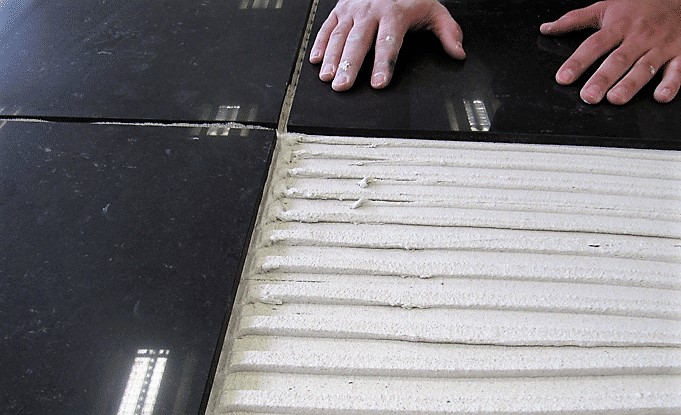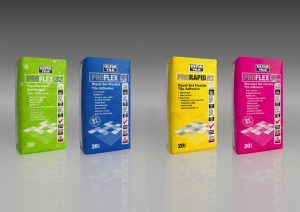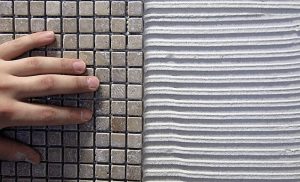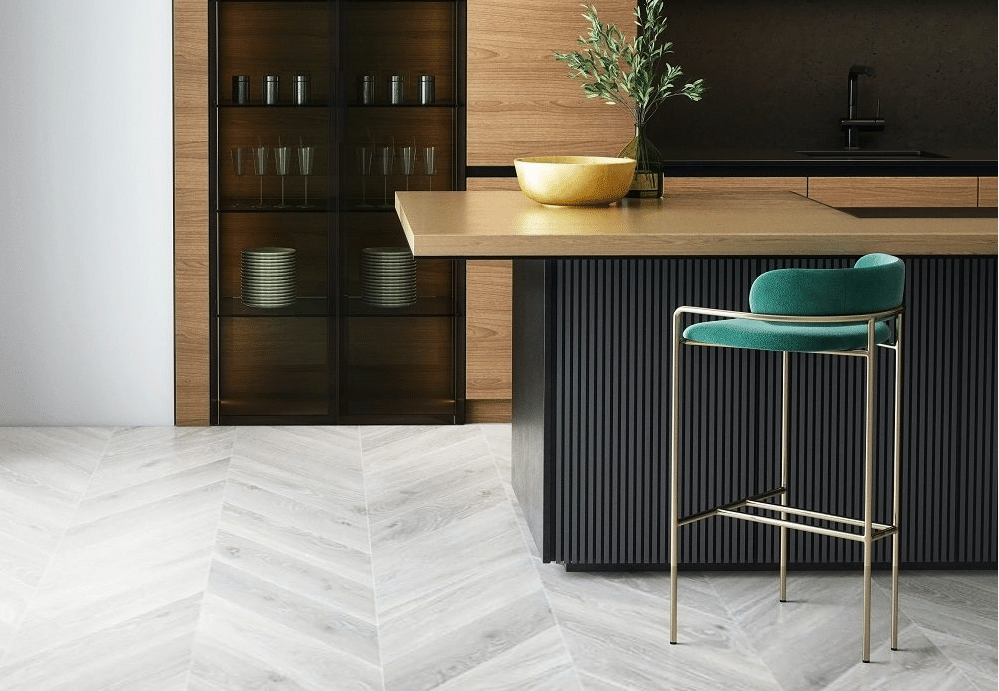Due to the demand of information related to the selection process of tile adhesives when installing floor heating, and the lack of content available on the topic; this guide was put together in partnership with UltraTile, experts in tile adhesives and underfloor heating.
This article will walk you through:
- Preparing your project: The first steps to consider prior to starting your project
- Understanding your adhesives: Choosing an adhesive that conforms with the European Quality Standards and understanding the coding and labelling found on adhesives
- Adhesives for electric systems
- Adhesives for water systems
Categorically speaking, there are two types of underfloor heating; hydronic and electric.
Hydronic systems, or “water systems” as some like to call them, consist of warm water pipes which can either be encased within the floor screed or fixed within pre-formed panels. The pipes are then laid throughout the subfloor to cover the floor area to be heated. Warm water systems are most popular in new builds since they are easiest to install when building the floor. However, nowadays there are also thin water pipes available on the market that suit renovations such as Total-16.
The second type of radiant heat available is electrical floor heating, which usually comes in two forms: heating mats and loose wires. Both of these are laid directly onto the subfloor or alternatively on insulation boards that will have been previously laid on the sub-floor.
Each heating system has different requirements of its tile adhesive and failure to choose the correct adhesive can have disastrous consequences for your flooring installation and affect your overall experience of floor heating.
Preparing your project
The starting point to a project is choosing the right materials that suit the project specifications. The better the material, the more reliable the results. Before you start your underfloor heating installations check:
- The project specification: Understanding the requirements of the project is the key in choosing the correct materials for it.
- Materials suit the project spec. You are best off checking that the materials you purchase are tested to European Standards and have a warranty and guarantee that promises you a new system in case something is not correct.
- Installation instructions. Always make sure that you follow the manufacturer’s installation manuals when mixing the adhesives and when installing an underfloor heating system. Every heating system is installed in a different way, so it is essential to follow the manufacturer’s guidelines regardless if you have installed a different system in the past. It is also notable that most of the warranties do not apply if the instructions in a manual have not been followed.
Understanding Your Adhesives:
European Standards for Adhesives
Next, we are going to look into the quality you should expect from an adhesive before making a purchase decision. Irrespective of your project, the adhesive should have undertaken some tests that conform to the European Standard for you to feel confident with your choice. This is because the tests will measure the level of polymer in an adhesive. The higher the level of polymer, the better the adhesive will perform in areas of temperature change – such as turning the heating on and off. Adhesives that do not perform well under the European Standards have a stronger likelihood of failing when used with underfloor heating.
The European Standards test the bond strength of an adhesive at 70ºC which is fundamental for an adhesive for floor heating. The bond strength is usually tested in:
- Dry conditions
- Under water (known as wet storage) and
- Freeze/thaw conditions.
UltraTile is a forerunner in the adhesive industry; thoroughly testing their adhesives’ durability in several conditions as well as with UFH. It is therefore recommended to shortlist when choosing an adhesive and go for trustworthy suppliers such as UltraTile.
Adhesive Labelling and Coding
When searching for suitable adhesives, you may come across descriptions on the packaging/ websites that look like coded language. The codes usually consist of a series of numbers and letters. The numbers and letters refer to the adhesive’s performance in the tests mentioned above. It is good to familiarise yourself with the codes to know what you are buying. You can find explanations for each code below:
C2 = Improved Cementitious Adhesive
An improved cementitious adhesive has a higher bond strength, which means it fixes tiles to difficult substrates easily. This classification is particularly important when using porcelain tiles.
F = Fast Setting
An adhesive which has been modified to set rapidly. This enables tiling and grouting to be carried out in a shorter time frame.
T = Reduced Slip
‘Slip’ refers to the vertical movement of a tile after it has been bedded into an adhesive. Traditionally, battens have been used to prevent slump, but modern adhesives are modified with reduced slip properties.
E = Extended Open Time
The time, usually in minutes, after application of an adhesive within which it will still bond and secure the tile.
S1 = Deformable Adhesive
This classification refers to an adhesive’s ability to withstand small movements, such as the expanding and contracting of floors where UFH has been installed.
S2 = Highly Deformable Adhesive
A highly deformable adhesive means it can withstand even more movement than an S1 classification adhesive – particularly important for UFH.
Now we have discussed the types of adhesives available on the market, we should remind ourselves of the factors to consider when choosing one:
The first things to look at when choosing the correct adhesive are:
- Subfloor. The subfloor can be solid (usually concrete) or wooden, and some adhesives are only compatible with certain subfloors.
- Underfloor heating system. The second factor that influences your choice is the type of the UFH system you will be using.
Let’s discuss the electric systems first.
UltraTile’s range of adhesives compatible with UFH
Adhesives for Electric Underfloor Heating Systems
Electric underfloor heating systems come in the form of either loose electric heating cables (also known as Loose Wire) or electric cables within mats. Loose wire systems need to be manually spaced by the installer to ensure even heat distribution throughout the floor surface. Matted systems, on the other hand, have a pre-spaced cable either attached to the mat, this would be the case with Warmup’s StickyMat electric floor heating system, for instance. Or, the cable is embedded within the mat itself; this would be the case for Warmup’s DCM-PRO Decoupling System.
As mentioned previously, what defines a performant flexible tile adhesive for UFH is an adhesive with a high level of polymer. Adhesives with a lot of polymer cope better with drastic changes in temperature. Furthermore, the temperatures at which high polymer adhesives are tested at to comply with European Standards are far higher than the temperature at which you will heat your floor; irrespective of how cold the weather gets.
All UltraTile adhesives comply with European Standards making them a safe option for UFH. However, some adhesives within the UltraTile range are better for some systems than others.
For example, if you are installing Warmup’s Inscreed electric floor heating system; an electric system that sits within a 50 to 100-millimetre bed of screed, your floor surface is less likely to be affected by sub-floor movements. This is because of the significant amount of screed and distance between the subfloor and the floor finish. Therefore, an entry level flexible tile adhesive such as UltraTile Pro-Rapid RS is a perfect match for an Inscreed installation.
On the other hand, you have matted and loose wire heating systems that sit only a few millimetres above the sub-floor and are very close to the floor finish. When a floor finish (such as tiles) sits so closely to the sub-floor, it is advised to:
– Use an adhesive with more flexibility than standard adhesives to cope with seasonal sub-floor movements
– Use an adhesive containing high polymer levels in order to deal with frequent temperature changes coming from the UFH system.
There are three flexible tile adhesives on the market that respond perfectly to these criteria:
- For wooden subfloors: UltraTile ProFlex SP: Is a highly flexible tile adhesive for wooden floors with high level of deformability, meaning it works great when laid over timber sub-floors which tend to move more than concrete sub-floors during seasonal temperature changes. Furthermore, it has a 2.5 hour set time, which is great for small areas as your working area will be dry shortly after you complete the installation.
- Large areas: UltraTile ProFlex SP+ES: Similarly to the previous product, this flexible tile adhesive contains a high level of polymer. However, it has a two-hour pot life and takes sixteen hours to set. This is perfect for large areas, as it allows you to mix and lay larger quantities of adhesive on the floor and maneuver the tiles with more freedom, all with less pressure to get it right before the adhesive dries. UltraTile ProFlex SP+ES makes therefore a great adhesive for under tile heating.
- Smaller areas and any subfloor type: UltraTile ProFlex S2: This is amongst the best flexible floor tile adhesives on the market, it has the highest level of deformability you can find, coupled with very short pot life and a rapid set-time (3.5 hours). This means that you get the best flexibility, with full capability to cope with temperature changes, and fast setting allowing you to complete your project quicker.
It is important to note that, even though some of the adhesives mentioned above are more suitable for certain types of installations than others for various reasons; all three adhesives are compatible with Loose Wire and Matted systems, and all three would perform well on wooden subfloors and/or in large areas.
Adhesives for water underfloor heating systems
Water underfloor heating systems create heat from a different source to electric systems, the former heats up water, the latter heats up metal wires. This fundamental difference in structure means that water floor heating systems are larger and take up significantly more space than electric systems.
This means that, for the majority of hydronic systems, more flexible tile adhesive will be required compared to an electric system. However, the adhesive properties required from the flexible tile adhesive are the same for wet systems as they are for electric systems:
- The adhesive needs to contain high levels of polymer to cope with frequent temperature changes.
- The adhesive needs to be flexible in order to cope with movement in the sub-floor without damaging your chosen floor surface.
For these reasons, the majority of flexible tile adhesives that are compatible with electric floor heating systems, are also compatible with water systems. That being said, there are some adhesives that we do not recommend using with certain systems in order to get the best results.
Warmup’s Total-16 is a good example to illustrate this point; the top of the range water system is a 16mm thick board that serves as an insulator as well as a holder for the water pipes that are later inserted into the board. The system is heavier than other wet floor heating systems due to its compact design, and the fact that it is manufactured in boards means that it is not as flexible as a plastic mat or pre-moulded retention clips.
For this reason, it is recommended to use a high-quality flexible tile adhesive such as UltraTile ProFlex S2. The deformability, durability, and capability of withstanding high and frequent temperature changes of this flexible tile adhesive are unequaled; making it the perfect match for a product like Warmup’s Total-16 water system.
On the other end of the spectrum, we would not recommend using an entry level (low priced) flexible tile adhesive for wet UFH systems due to their lack of flexibility compared to electric systems.
When it comes to standard water systems, UltraTile ProFlex SP and UltraTile ProFlex SP+ES are more than capable of coping with the demands of water underfloor heating and regular sub-floor movement.
Main Points to Remember
When searching for a suitable flexible tile adhesive for your floor heating job remember:
- To only go for adhesives that are marketed as compliant with European Standard.
- Familiarise yourself with the labeling/ coding of the adhesives.
- Look for a higher than average polymer level for the adhesive to be able to cope with frequent temperature changes.
- The adhesive must be highly flexible to cope with sub-floor movement.
If you are purchasing a top-of-the-range radiant heating system, you will want to accompany this with a top-of-the-range flexible tile adhesive, as a cheap adhesive under or above a good heating system could affect the performance of the floor heating system that you have paid handsomely for.
On the other hand, if you have bought an entry level, low-priced floor heating system, be that electric or warm water, you will still need to buy a flexible tile adhesive that complies with European Standards and ticks both boxes mentioned above related to polymer and deformability.
Warmup has an extensive range of both electric and water systems, from entry-level, low-priced systems, to top-of-the-range, more expensive systems. You can browse these products by clicking here.
UltraTile from Instarmac have every adhesive, primer and leveling compound you will need to accompany your chosen Warmup Underfloor Heating System.






![Thumbnail [200x250]](/wp-content/uploads/Electric-Category-Page-Image.jpg)
![Thumbnail [200x250]](/wp-content/uploads/Hydronic-Category-Page-Image-1.jpg)